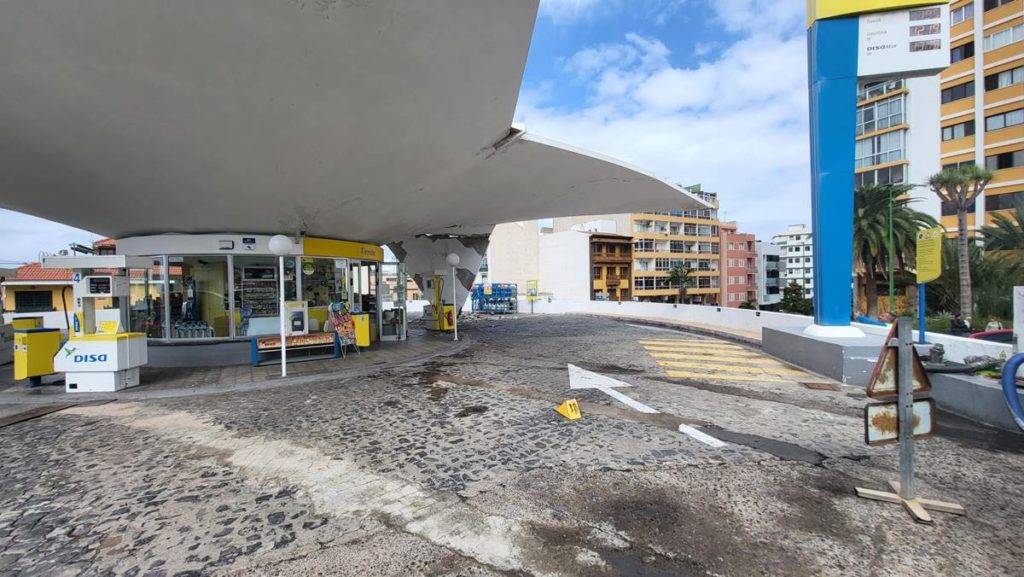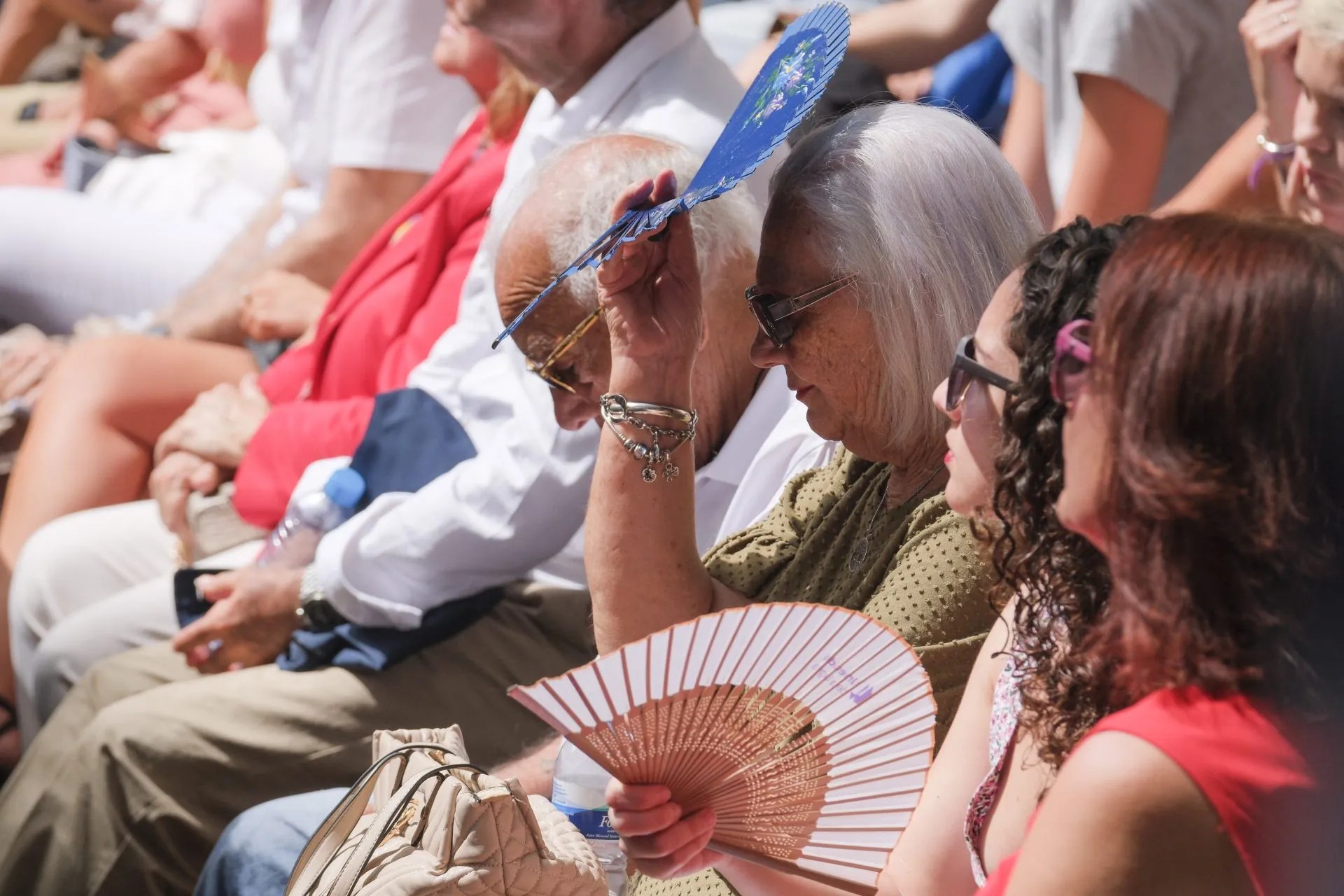Porto residents were left in awe recently by the news of a section of the roof at the La Estrella petrol station collapsing, albeit without any personal injuries. One of the six points of the distinctive star-shaped roof that defines this iconic urban feature in the popular city bowed and fell to the ground. This incident led to the closure of the station to the public, reinforcement works, and the cordoning off of the entire building perimeter, which has stood at Punta de la Carretera for over half a century.
The incident revealed to many citizens that this vintage and unique petrol station is, in fact, designated as a BIC, a safeguarded architectural monument that is currently in a concerning state of disrepair due to its age and lack of upkeep. Particularly, the lower section of the station’s facilities, housing the car washes, has been shuttered and left abandoned for numerous decades.
Puerto de la Cruz extends beyond being just a tourist hotspot. The numerous historical and cultural values within its compact 9 square kilometers often go unnoticed by tourists, but more alarmingly, even by the local residents. The Old House of the Royal Customs, the La Peña de Francia parish, the Ventoso palace, the San Amaro church, Peñón del Fraile, San Francisco church, Cal de Las Cabezas ovens, House of Miranda, Risco de Oro estate, Cloguen House, old Marquesa hotel, Sitio Litere, old Taoro hotel, Botanical Garden…
The roster of heritage values and culturally significant assets in this northern municipality is far more extensive than initially perceived. Additionally, it harbours some lesser-known curiosities. One of these hidden gems pertains to the DISA petrol station at Punta de la Carretera, colloquially known as La Estrella due to its distinct six-pointed roof. Erected in the early ’60s and still operational, this station is catalogued in the municipal register of preserved structures and falls under the cultural interest asset declaration (BIC) of Porto’s historic centre. Its top-tier protection status is attributed to its status as an authentic architectural monument. Conceived by architect Luis Cabrera Sánchez-Real, La Estrella clinched the Manuel Oráa Award from the College of Architects of the Canary Islands for being hailed as “a work of engineering art and an outstanding instance of pioneering forms and construction solutions.”
Such is the uniqueness and value of this avant-garde petrol station that it necessitated a revision of the city’s General Planning Plan, which initially aimed to remove it to make way for a sizable urban boulevard cutting across the heart of Puerto de la Cruz, from Martiánez to the El Tejar industrial zone. This ambitious municipal scheme had to be recalibrated to ensure the preservation of La Estrella station, revered as an architectural emblem symbolising the tourism boom that Puerto de la Cruz underwent in the ’60s.


A Symbol of Porto
Today, more than five decades since its conception, it continues to serve and enhance the strategic exit point of the city through the Punta de la Carretera sector, standing in the shadow of another city symbol – albeit less aesthetically pleasing – the Belair building, a 24-storey architectural eyesore, facing the Atalaya del Taoro Gardens with the Tamaragua Hospital to its rear. La Estrella endures nestled in the heart of Puerto de la Cruz. The upper level housing the DISA petrol pumps remains fully operational, while the lower level, once housing the washrooms and servicing bays, has been inactive and cordoned off for an extended period.
According to researcher Melecio Hernández, the La Estrella petrol station was a joint venture initiated in 1960 by DISA and Portuguese entrepreneur José Manuel Sotomayor, who managed it for many years.
The project, finalised in 1964, was bestowed with the Manuel de Oráa Award by the College of Architects of the Canary Islands, lauded as a pinnacle of engineering. As per project documents, the initial budget for material execution totalled 1,368,409.73 pesetas.
The project’s descriptive report stated that “its strategic position within the town’s traffic infrastructure suggests that it caters to all vehicular traffic within the vicinity. Consequently, the inclusion of servicing and cleaning facilities planned at the basement area, accessible from Valois Street, is deemed beneficial. Behind this level are the requisite hygiene facilities for mechanics. A spiral staircase surrounding the central roof support links this level to the upper fuel dispensing office, organised with parking for vehicles around the central office. The upper-level services are shielded by a reinforced concrete canopy, supported by a central pillar.”
Many locals stumbled upon this architectural gem of Puerto de la Cruz at an exhibition hosted by the Tenerife Island Council at TEA, coinciding with World Architecture Day, titled Forms on the plane, dedicated wholly to the drawings and projects of architect and urban planner Luis Cabrera housed at the Historical Archive of the College of Architects of Tenerife. The exhibition catalogue highlighted Cabrera’s work as “noteworthy for its originality and inclination towards experimentation. The introduction of novel forms and construction solutions in the early ’50s positions him as a vital component in comprehending the functional and typological rejuvenation of architecture in Tenerife.”
In 2005, the official College of Architects of the Canary Islands produced a book showcasing the works of Luis Cabrera Sánchez del Real in Tenerife. The study’s author, Eladio Arteaga, dedicated an entire chapter to outlining the DISA-La Estrella petrol station project, labelling it as “a geometric marvel.”
Rose of the Compass
This is the technical and evaluative description Eladio Arteaga offered of the exceptional and singular petrol station in Porto: “In a locale marked by significant terrain variations and a unique form, a meticulously defined element is incorporated into its geometry, resolving not only as a formal boundary, but also a crucial juncture for what was then the entry point to Puerto de la Cruz, at Punta de la Carretera. As an articulating element – akin to a compass rose – this six-pointed umbrella crafted from reinforced concrete panels unmistakably adheres to the advanced structural models introduced by Félix Candela, a precedent not lost on Luis Cabrera. The petrol station, greeting the incoming traffic, resembles a grand dynamo receiving and dispatching vehicles. A centrifugal-centripetal motion, evident at every level and in each detail observed in the structure, from the foundation to the intermediate slab, from the substantial central pillar to the finishing canopy – the roots, trunk, branches, and the tree’s crown. Even the ensuing reinforcement of the canopy structure further accentuates this aforementioned dynamic trait.”
Arteaga notes that as per details from the revised 1962 project, this integration, arising from a deliberate decision in the canopy structure, never appears as a mere answer to a problem but rather a fresh challenge for Cabrera. It is underscored that not only does it stay true to the carousel’s initial concept, but it also seizes the opportunity to position the water tank high atop the central pillar, initiating the braces from it toward each end of the lamellar structure. A truly distinctive edifice.















